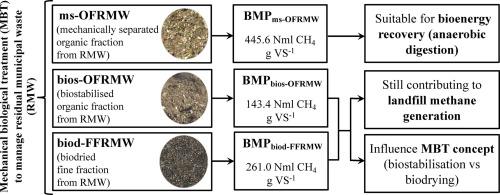Waste Management ( IF 8.1 ) Pub Date : 2020-06-03 , DOI: 10.1016/j.wasman.2020.05.021 Manuela Carchesio 1 , Martina Di Addario 1 , Fabio Tatàno 1 , Sandro de Rosa 2 , Alma Gambioli 2

|
Mechanical biological treatment (MBT) approaches are being adopted to manage residual municipal waste (RMW) to promote the prevention or reduction of potential environmental impacts of landfilling. From this perspective, the present study aimed to increase the knowledge of the biological (anaerobic) stability of different MBT organic outputs and, conversely, initial methane generation from residual organic waste. Biochemical methane potential (BMP) tests, along with initial and final characterisations of substrates and digestates, were conducted on: a mechanically separated organic fraction from RMW (ms-OFRMW); a first MBT organic output represented by a biostabilised organic fraction from RMW (bios-OFRMW); and a different MBT organic output represented by a biodried fine fraction from RMW (biod-FFRMW). The ms-OFRMW had a BMP of 445.6 Nml CH4 g VS−1, which was comparable or even higher than those from separately collected and source-sorted organic fractions. The fibre and liquor fractions of the digestate from ms-OFRMW with inoculum showed potential profiles of P-rich amendment and N-rich fluid phase, respectively, even satisfying environmental limits (with the exclusion only of Cu and Zn contents in fibre fraction that, however, remained within typical ranges for agricultural digestates). The BMPs for bios-OFRMW and biod-FFRMW were 143.4 and 261.0 Nml CH4 g VS−1, respectively, indicating that these streams may still contribute to landfill methane generation. The BMPs for bios-OFRMW, biod-FFRMW, and ms-OFRMW were positively associated with the degrees of conversion of the substrates (17, 32, and 55%, respectively) and the potential dynamic respiration indexes (955, 3126, and 6062 mg O2 kg VS−1 h−1, respectively).
中文翻译:

评估用于填埋的残留有机部分和经机械生物处理的有机产品的生化甲烷潜力。
正在采用机械生物处理(MBT)的方法来管理残留的城市废物(RMW),以促进预防或减少填埋的潜在环境影响。从这个角度出发,本研究旨在增加对不同MBT有机产品的生物(厌氧)稳定性的认识,反之,则是从残留有机废物中初步产生甲烷。进行生化甲烷潜力(BMP)测试,以及底物和消化物的初始和最终表征,方法是:从RMW(ms-OFRMW)机械分离的有机馏分;以RMW(bios-OFRMW)的生物稳定有机部分为代表的第一批MBT有机产品;以及以RMW(biod-FFRMW)的生物干燥细级分表示的MBT有机产量不同。ms-OFRMW的BMP为445.6 Nml CH4 g VS -1,与单独收集和来源分类的有机馏分的结果相当或更高。含接种物的ms-OFRMW消化液中的纤维和液体馏分分别显示出富含P的修饰物和富含N的流体相的潜在分布图,甚至满足环境限制(不包括纤维部分中的Cu和Zn含量,但是,仍保持在典型的农业消化范围内)。bios-OFRMW和biod-FFRMW的BMP分别为143.4和261.0 Nml CH 4 g VS -1,分别表明这些流可能仍有助于填埋甲烷的产生。bios-OFRMW,biod-FFRMW和ms-OFRMW的BMP与底物的转化度(分别为17、32和55%)和潜在的动态呼吸指数(955、3126和6062)呈正相关mg O 2 kg VS -1 h -1)。



























 京公网安备 11010802027423号
京公网安备 11010802027423号